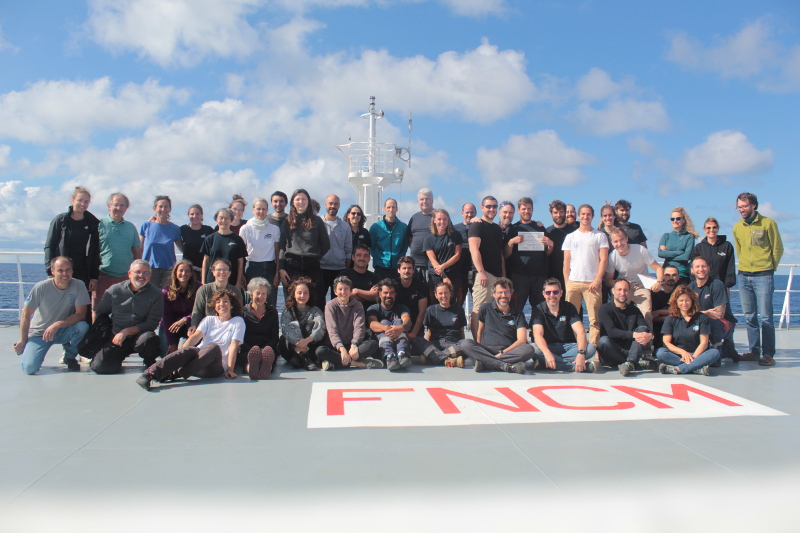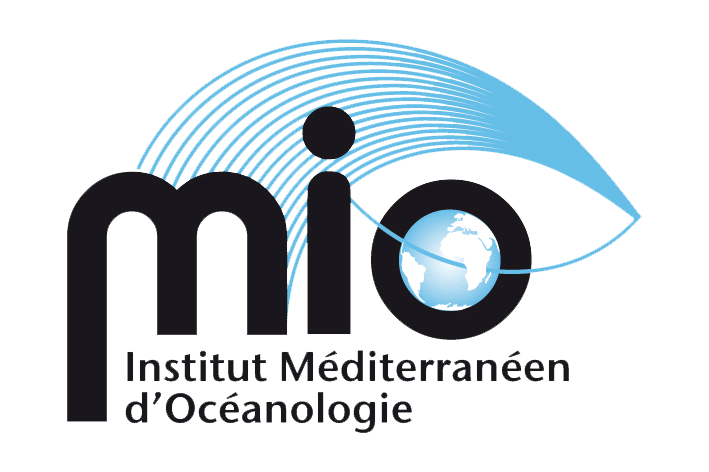The BioSWOT-Med campaign ended on Sunday 14 May after four weeks of navigation in a zone characterised by a persistent front between modified Atlantic waters of different ages around 100 km north-east of the island of Menorca (Spain) under the trajectory of the SWOT satellite. The BioSWOT-Med scientific team is fully satisfied with the data acquired and would like to thank the captain and crew of the R/V L'Atalante, who made an excellent campaign possible despite the difficult weather conditions.

The BioSWOT-Med team and the crew of the R/V L'Atalante
By the BioSWOT-Med team
Today, Sunday 14 May, after 4 weeks at sea, we are finally back in La Seyne-sur-Mer. Our BIOSWOT-Med campaign is now over, to the great satisfaction of the scientific team.
In the end, we chose an area around 100 km north-east of the island of Menorca (Spain), in the path of the SWOT satellite, launched a few months ago. Just at the start of our cruise, a much-appreciated surprise was the availability of preliminary images, almost in real time, of sea surface height from SWOT. These images, produced for us by the SWOT project (CNES, NASA and JPL) have revolutionised our strategy, enabling us to pinpoint the position and shape of fronts or eddies to an unprecedented accuracy of just a few kilometres.
We were also lucky enough to have several cloud-free days just before the cruise, which corresponded to a sequence of several high-resolution surface chlorophyll maps from the OLCI-Sentinel 3 sensor. Combined with our terrestrial satellite analysis using the 'SPASSO' toolbox developed as part of the SWOT-AdAC consortium, SWOT and Sentinel-3 drew for us the physical and biological seascape of our region.
We headed for a persistent front between modified Atlantic waters of different ages around 100 km north-east of Menorca. We spent three weeks there exploring fine-scale ocean dynamics and their impact on plankton diversity. Although ideal for our scientific questions, this region is difficult in terms of navigation. The strong northerly winds, the tramontana and mistral, contribute to the transformation of local water masses, but at the same time can create difficult conditions for shipboard operations.
On the whole, we were able to produce all the vertical profiles we had planned, and even more runs than planned for CTD-rosette, and for FFADCP and VMP (vertical velocity and turbulence respectively).
A large number of plankton nets were set and the plankton was also studied in mesocosms (Waipapa Taumata Rau University of Auckland).
Our experiment also benefited from autonomous instrumented platforms, which provided observations from different parts of the ship simultaneously and even during storms. Several gliders were successfully deployed and recovered: two MIO gliders (France), one MOOSE glider (France), the University of Bergen glider (Norway) and the Zooglider SCRIPPS (US). The latter was recovered south of Minorca, where it was blocked by very strong currents, and was redeployed to the main study area before finally being recovered at the end of the mission.
Six ARGO profiling floats from OGS (Italy) and LEFE-GMMC (France) were deployed. These instruments are still drifting in the study area and provide very useful information on the evolution of post-cruise conditions.
In order to validate the new observations from the SWOT satellite and to study the details of ocean currents, a large number of surface drifters were released: 10 SVPs and 10 CODEs (OGS, Italy), 20 CARTHEs (ISMAR-CNR), 15 eOdyns (international SWOT-AdAC consortium), two Spotters (LOPS) and 8 additional SVPs from SCRIPPS Inst. (US). A prototype surface drifter buoy equipped with a biogeochemical sensor array (ISMAR-CNR, Rome) was deployed and recovered before leaving the study area.
One of our prototypes designed to measure vertical velocities, the Vertical Velocity Profiler (VVP), was unfortunately lost during the first station, probably due to a malfunction of the instrument and/or the positioning system. The MIO scientific team therefore improved the second prototype, which produced numerous vertical profiles.
The Moving Vessel Profiler (MVP) (GENAVIR and MIO, France) has produced over 1,400 high-resolution multiparameter profiles.
All the water samples pumped worked well, thanks also to the help and technical support of the crew, who considerably upgraded the scientists' equipment with parts made on board!
The cytometer and spectrometer acquisitions on the thermosalinometer water inlet also worked perfectly, and the ADCP and single-beam echosounder acquisitions were fully satisfactory.
Over 500,000 litres of seawater were sampled and analysed for biogeochemical properties.
In conclusion, the scientists benefited from a well-equipped, high-performance vessel. The captain of the R/V L'Atalante Gilles Ferrand and his competent, enthusiastic and accommodating crew deserve our thanks for their work, which made for a great campaign!
Consult the BioSWOT-Med timeline
More information




